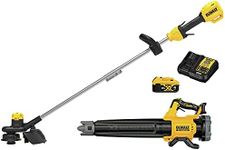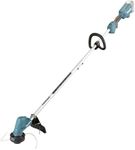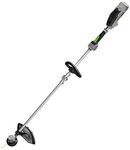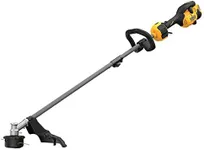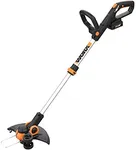Buying Guide for the Best Battery Operated Weed Trimmer
Choosing a battery-operated weed trimmer can make yard work much easier and more convenient, especially if you want to avoid the hassle of cords or the maintenance of gas engines. The right trimmer for you will depend on the size of your yard, the type of weeds or grass you need to cut, and how comfortable you want the tool to be during use. Understanding the main features and how they relate to your needs will help you make a smart choice.Battery VoltageBattery voltage tells you how powerful the trimmer is. Higher voltage usually means more cutting power, which is helpful for thicker weeds or larger areas. Trimmers typically range from about 18V to 60V. Lower voltage models are lighter and easier to handle, making them good for small yards and light trimming. Higher voltage models are heavier but can handle tougher jobs and bigger spaces. Think about the type of weeds you have and the size of your yard to decide what level of power you need.
Battery Capacity (Ah)Battery capacity, measured in amp-hours (Ah), tells you how long the trimmer can run on a single charge. A higher Ah rating means longer run time before you need to recharge. For small yards or quick jobs, a lower capacity battery may be enough. If you have a larger area or want to avoid frequent recharging, look for a higher Ah rating. Consider how long you usually spend trimming to help you choose the right capacity.
Cutting WidthCutting width is the size of the area the trimmer can cut in one pass, usually measured in inches. A wider cutting width lets you cover more ground faster, which is useful for big yards. However, a smaller cutting width can be easier to control and better for tight spaces or detailed work. Think about whether you need speed for large open areas or precision for smaller, tricky spots.
WeightThe weight of the trimmer affects how comfortable it is to use, especially for longer periods. Lighter trimmers are easier to handle and less tiring, which is great if you have a lot of edging or trimming to do. Heavier models may offer more power but can be harder to maneuver. Consider your own strength and how long you plan to use the trimmer at a time when deciding what weight is best for you.
Line Feed SystemThe line feed system controls how the cutting line is released as it wears down. There are manual, bump, and automatic feed systems. Manual systems require you to stop and adjust the line yourself, which can be slower. Bump feed lets you tap the trimmer head on the ground to release more line, which is convenient for most users. Automatic feed systems release line as needed without any action from you, making them the easiest to use. If you want less hassle, look for bump or automatic feed.
Adjustable FeaturesSome trimmers offer adjustable handles, shafts, or cutting angles to make them more comfortable and versatile. Adjustable handles and shafts help you find a comfortable working position, especially if you are taller or shorter than average. Adjustable cutting angles can make it easier to edge along sidewalks or flower beds. If comfort and flexibility are important to you, look for models with these features.
Charging TimeCharging time is how long it takes to fully recharge the battery. Shorter charging times mean less waiting between uses, which is helpful if you have a lot of work to do or forget to charge in advance. If you want to be able to get back to work quickly, look for a trimmer with a fast-charging battery or consider buying a spare battery.
